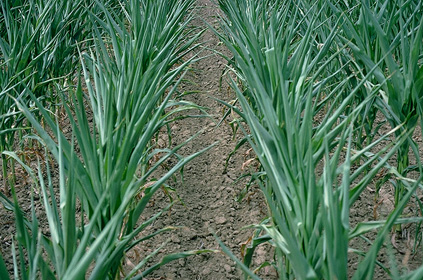Since about the last week of June, conditions have been about perfect for corn growth and development across parts of Indiana. Clear skies, low humidity, warm day-time temperatures, and cool night-time temperatures are about as good as it can get for America's favorite crop. However, there is the usual healthy dose of pessimism down at the Chat 'n Chew Cafe. It seems that some fields of corn in the neighborhood have been exhibiting various degrees of leaf rolling during the past several weeks. Surely the corn crop couldn't be experiencing drought stress after so much rain this spring?

Leaf rolling is indeed a response of the corn plant to insufficient plant moisture content. As plant moisture content declines, the corn plant often 'protects' itself from excessive plant moisture loss (transpiration) by rolling its leaves. The rolled leaf offers less exposed surface area and transpiration is reduced. Thus, the act of leaf rolling is a sort of defensive posture by the corn plant against inadequate plant moisture. In fact, one should probably prefer a hybrid whose leaves roll readily over one that remains unrolled during times of severe plant moisture deficits.

Take the time to determine the true cause of leaf rolling this year. Plant moisture deficits do not necessarily reflect simply an unavailability of soil moisture. Other factors may not allow the corn plant to take up the soil moisture it requires. Consider some of the following problems that can cause plant moisture deficits. Coupled with low humidity and high temperatures, these factors can quickly cause insufficient plant moisture contents.
Soil compaction is quite severe in many Indiana corn fields this year because of the predicament many corn growers faced of having to till or plant soil that was really too wet for field work. Soil compaction not only restricts rooting depth of the corn plant, but also soil moisture availability to the plant. Soil moisture in compacted soil layers is much less available to the plants roots than in uncompacted soil. Leaf rolling, therefore, occurs more quickly in compacted areas of fields.
Shallow rooting caused by earlier cold, wet soils (see Early-Season Root Development in Corn) increases the vulnerability of corn to subsequent drying out periods. Shallow rooting contributed to the severe yield losses suffered
during the droughts of 1991 and 1995 following similar cool, wet springs.
Root damage by the feeding activities of the corn rootworm larvae can easily result in a restricted root system that is unable to provide the plant with sufficient water uptake to prevent leaf rolling. Leaf rolling due to rootworm damage of the roots occurs even more easily when coupled with severe soil compaction that limits the availability of soil moisture.
Restricted root development in late-planted corn caused by rapidly drying surface soils can cause not only the infamous Floppy Corn Syndrome (see Potential for Floppy Corn in Late-Planted Fields), but also severe leaf rolling if hot, dry conditions persist. Obviously, if these stunted root systems have also been attacked by corn rootworm larvae or are further restricted by severe soil compaction, the leaf rolling will be accentuated.
Leaf rolling itself does not always translate to grain yield loss in corn. The extent of any yield loss depends on the nature of the problem(s) that is reflected by the leaf rolling symptom.
'Ordinary' leaf rolling during the heat of the day, when transpiration cannot keep up with high temperatures and low humidity, is a defensive posture by the corn plant and won't affect yield. If true drought stress develops and leaf rolling persists for 12 hours or more a day, then grain yield would likely decrease, particularly during the two weeks before to two weeks after pollination.
If the leaf rolling is an indicator of other severe root problems as described above, then yield loss is more likely to occur. Take the time to diagnose the cause(s) of the leaf rolling. If tillage or planting mistakes have been made, learn from them. If the problem can be corrected, do so. If the problem can be prevented next year, do so.
![]() Return to the the Chat 'n Chew
Cafe.
Return to the the Chat 'n Chew
Cafe.
![]() The Corn Growers Guidebook , a WWW
resource for corn management systems in Indiana and the eastern CornBelt.
The Corn Growers Guidebook , a WWW
resource for corn management systems in Indiana and the eastern CornBelt.
![]() Purdue University Agronomy Extension
WWW Home Page.
Purdue University Agronomy Extension
WWW Home Page.
![]() Purdue Agronomy On-Line! ,
Purdue's Agronomy Department WWW Home Page.
Purdue Agronomy On-Line! ,
Purdue's Agronomy Department WWW Home Page.